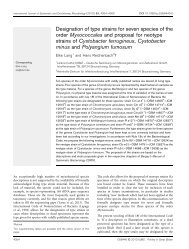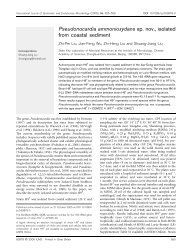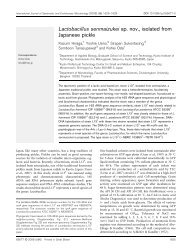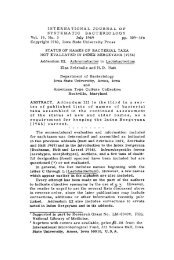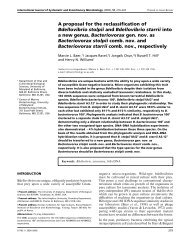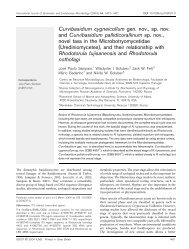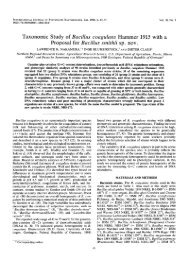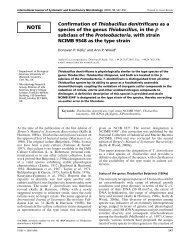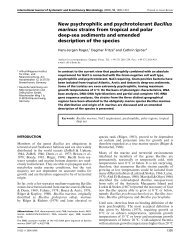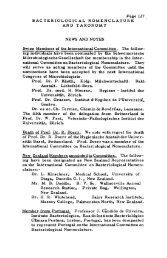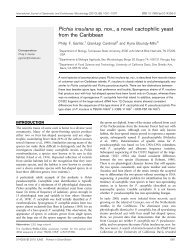Azospirillum zeae sp. nov., a diazotrophic bacterium isolated from ...
Azospirillum zeae sp. nov., a diazotrophic bacterium isolated from ...
Azospirillum zeae sp. nov., a diazotrophic bacterium isolated from ...
Create successful ePaper yourself
Turn your PDF publications into a flip-book with our unique Google optimized e-Paper software.
International Journal of Systematic and Evolutionary Microbiology (2007), 57, 2805–2809 DOI 10.1099/ijs.0.65128-0<br />
Corre<strong>sp</strong>ondence<br />
George Lazarovits<br />
lazarovitsg@agr.gc.ca<br />
Diverse nitrogen-fixing bacteria have been <strong>isolated</strong> <strong>from</strong><br />
the roots of numerous wild and cultivated grasses grown in<br />
tropical, subtropical and temperate regions all over the<br />
world. Among these bacteria, <strong>Azo<strong>sp</strong>irillum</strong> <strong>sp</strong>p. have been<br />
<strong>isolated</strong> <strong>from</strong> various geographical regions of the world.<br />
Members of this genus are known to be associated with<br />
roots of numerous wild and cultivated grasses, cereals, food<br />
crops and soils in various regions (Peng et al., 2006). The<br />
genus <strong>Azo<strong>sp</strong>irillum</strong> was first described by Tarrand et al.<br />
(1978) and comprised two <strong>sp</strong>ecies: <strong>Azo<strong>sp</strong>irillum</strong> lipoferum<br />
and <strong>Azo<strong>sp</strong>irillum</strong> brasilense. The genus currently comprises<br />
10 <strong>sp</strong>ecies, including <strong>Azo<strong>sp</strong>irillum</strong> amazonense (Magalhães<br />
et al., 1983), <strong>Azo<strong>sp</strong>irillum</strong> halopraeferens (Reinhold et al.,<br />
1987), <strong>Azo<strong>sp</strong>irillum</strong> irakense (Khammas et al., 1989), <strong>Azo<strong>sp</strong>irillum</strong><br />
largimobile (Ben Dekhil et al., 1997), <strong>Azo<strong>sp</strong>irillum</strong><br />
doebereinerae (Eckert et al., 2001), <strong>Azo<strong>sp</strong>irillum</strong> oryzae (Xie<br />
& Yokota, 2005), <strong>Azo<strong>sp</strong>irillum</strong> melinis (Peng et al., 2006)<br />
Abbreviation: IAA, indole acetic acid.<br />
The GenBank/EMBL/DDBJ accession numbers for the 16S rRNA,<br />
cpn60 and nifH gene sequences of strain N6 are DQ682469,<br />
DQ682474 and DQ682471, re<strong>sp</strong>ectively; the corre<strong>sp</strong>onding accession<br />
numbers for strain N7 T are DQ682470, DQ682473 and DQ682472.<br />
<strong>Azo<strong>sp</strong>irillum</strong> <strong>zeae</strong> <strong>sp</strong>. <strong>nov</strong>., a <strong>diazotrophic</strong><br />
<strong>bacterium</strong> <strong>isolated</strong> <strong>from</strong> rhizo<strong>sp</strong>here soil of<br />
Zea mays<br />
Samina Mehnaz, 1,2 Brian Weselowski 2 and George Lazarovits 2<br />
1<br />
School of Biological Sciences, Quaid-e-Azam Campus, University of the Punjab, Lahore 54590,<br />
Pakistan<br />
2 Southern Crop Protection and Food Research Centre, Agriculture and Agri-Food Canada,<br />
1391 Sandford Street, London, ON N5V 4T3, Canada<br />
Two free-living nitrogen-fixing bacterial strains, N6 and N7 T , were <strong>isolated</strong> <strong>from</strong> corn rhizo<strong>sp</strong>here.<br />
A polyphasic taxonomic approach, including morphological characterization, Biolog analysis,<br />
DNA–DNA hybridization, and 16S rRNA, cpn60 and nifH gene sequence analysis, was taken to<br />
analyse the two strains. 16S rRNA gene sequence analysis indicated that strains N6 and N7 T<br />
both belonged to the genus <strong>Azo<strong>sp</strong>irillum</strong> and were closely related to <strong>Azo<strong>sp</strong>irillum</strong> oryzae (98.7<br />
and 98.8 % similarity, re<strong>sp</strong>ectively) and <strong>Azo<strong>sp</strong>irillum</strong> lipoferum (97.5 and 97.6 % similarity,<br />
re<strong>sp</strong>ectively). DNA–DNA hybridization of strains N6 and N7 T showed reassociation values of 48<br />
and 37 %, re<strong>sp</strong>ectively, with A. oryzae and 43 % with A. lipoferum. Sequences of the nifH and<br />
cpn60 genes of both strains showed 99 and ~95 % similarity, re<strong>sp</strong>ectively, with those of A.<br />
oryzae. Chemotaxonomic characteristics (Q-10 as quinone system, 18 : 1v7c as major fatty acid)<br />
and G+C content of the DNA (67.6 mol%) were also similar to those of members of the genus<br />
<strong>Azo<strong>sp</strong>irillum</strong>. Gene sequences and Biolog and fatty acid analysis showed that strains N6 and<br />
N7 T differed <strong>from</strong> the closely related <strong>sp</strong>ecies A. lipoferum and A. oryzae. On the basis of these<br />
results, it is proposed that these nitrogen-fixing strains represent a <strong>nov</strong>el <strong>sp</strong>ecies. The name<br />
<strong>Azo<strong>sp</strong>irillum</strong> <strong>zeae</strong> <strong>sp</strong>. <strong>nov</strong>. is suggested, with N7 T (5NCCB 100147 T 5LMG 23989 T ) as the type<br />
strain.<br />
and <strong>Azo<strong>sp</strong>irillum</strong> canadense (Mehnaz et al., 2007). In<br />
studies aimed at identifying the bacterial rhizo<strong>sp</strong>here<br />
Fig. 1. Electron micrograph showing cell morphology of corn<br />
isolate N6. Bar, 0.6 mm.<br />
65128 G 2007 Crown copyright Printed in Great Britain 2805
S. Mehnaz, B. Weselowski and G. Lazarovits<br />
Table 1. Physiological differences between <strong>Azo<strong>sp</strong>irillum</strong> <strong>zeae</strong> <strong>sp</strong>. <strong>nov</strong>. isolates N6 and N7 T and<br />
other <strong>Azo<strong>sp</strong>irillum</strong> <strong>sp</strong>ecies<br />
Taxa: 1, A. <strong>zeae</strong> N7 T and N6; 2, A. oryzae IAM 15130 T ;3,A. lipoferum ATCC 29707 T ;4,A. melinis TMCY<br />
0552 T ;5,A. doebereinerae. +, Positive; –, negative; V, variable; ND, not determined. Data for carbon source<br />
utilization by A. oryzae, A. lipoferum and A. melinis are <strong>from</strong> Mehnaz et al. (2007); data for N6, N7 T and A.<br />
doebereinerae are <strong>from</strong> this study. Other data for A. oryzae, A. lipoferum, A. melinis and A. doebereinerae are<br />
taken <strong>from</strong> Eckert et al. (2001), Peng et al. (2006) and Xie & Yokota (2005).<br />
Characteristic 1 2 3 4 5*<br />
Motility + + + 2 +<br />
Biotin requirement 2 + + 2 2<br />
Growth with 2 % NaCl 2 2 2 + 2<br />
Growth at 41 uC + 2 2 2 2<br />
Optimum growth temperature (uC) 30 30 37 20–33 30<br />
pH range for growth 5.0–7.0 6.0–7.0 6.0–7.0 4.0–8.0 6.0–7.0<br />
Gelatin hydrolysis 2 + + ND 2<br />
Carbon source utilization:<br />
N-Acetyl-D-glucosamine V 2 + + 2<br />
L-Arabinose + + + + +<br />
D-Cellobiose 2 2 2 2 2<br />
D-Fructose + + + + +<br />
L-Fucose + 2 + + 2<br />
D-Galactose + + + + +<br />
Gentiobiose 2 2 2 2 2<br />
D-Glucose V + + + +<br />
Glycerol + + + + +<br />
myo-Inositol 2 2 + 2 2<br />
Lactose 2 2 2 2 2<br />
Maltose 2 2 2 + 2<br />
D-Mannitol + 2 + + +<br />
D-Mannose 2 2 + 2 2<br />
L-Rhamnose 2 2 2 2 2<br />
D-Sorbitol + 2 2 + +<br />
Sucrose 2 2 2 2 2<br />
Trehalose 2 2 2 2 2<br />
DNA G+C content (mol%) 67.6 66.8 69–70 68.7 70.7<br />
*DNA G+C content and carbon source utilization data are for A. doebereinerae GSF71 T ; all other data refer<br />
to more than one strain.<br />
residents of corn plants grown in Southern Ontario,<br />
Canada, several bacterial strains were <strong>isolated</strong> <strong>from</strong> soil<br />
adhering to corn roots. Some of them were found to fix<br />
nitrogen and form pink dry colonies on malate medium.<br />
These bacteria were compared with <strong>Azo<strong>sp</strong>irillum</strong> <strong>sp</strong>p. by<br />
using microbial and molecular biology techniques.<br />
Previously, on the basis of partial 16S rRNA gene<br />
sequencing, isolate N7 T was identified and reported as A.<br />
lipoferum (Mehnaz & Lazarovits, 2006). In this study, this<br />
isolate has been re-identified and isolation and identification<br />
of another <strong>Azo<strong>sp</strong>irillum</strong> strain, N6, <strong>from</strong> corn rhizo<strong>sp</strong>here<br />
using a polyphasic approach is reported.<br />
Isolates N6 and N7 T were <strong>isolated</strong> on M medium (Xie<br />
&Yokota, 2005) except that biotin was not added and the<br />
medium was pH 7.2–7.4. Subcultivation was done on the<br />
same medium at 30 uC for 48–72 h. The isolates formed<br />
flat pink colonies on M medium. With time, these colonies<br />
became dried and wrinkled. Cell morphology was observed<br />
by transmission electron microscopy (Zeiss EM902). Cell<br />
morphology of N6 and N7 T was similar. Both strains<br />
showed a single polar flagellum in liquid medium,<br />
although N7 T cells were bigger than those of N6; cells of<br />
N6 were 0.9–1.161.9–3.3 mm (Fig. 1) and those of N7 T<br />
were 1.563.4–6.8 mm. Bacterial growth at different<br />
temperatures (20–41 uC), pH values (4–10) and various<br />
NaCl concentrations (0.5–3.0 %) was determined on M<br />
medium. The Biolog analysis system and API 20NE<br />
bacterial identification kit were used for physiological<br />
characterization. Results of the analyses are given in the<br />
<strong>sp</strong>ecies description. A summary of the results, including<br />
carbon source utilization tests, suitable for the differentiation<br />
of isolates N6 and N7 T <strong>from</strong> known <strong>Azo<strong>sp</strong>irillum</strong><br />
<strong>sp</strong>ecies is presented in Table 1. In Table 1, N6, N7 T and A.<br />
2806 International Journal of Systematic and Evolutionary Microbiology 57
Table 2. Cellular fatty acid composition of corn rhizo<strong>sp</strong>here<br />
isolates N6 and N7 T and closely related <strong>Azo<strong>sp</strong>irillum</strong> <strong>sp</strong>ecies<br />
Strains: 1, N6; 2, N7 T ;3,A. oryzae IAM 15130 T (data <strong>from</strong> Mehnaz<br />
et al., 2007); 4, A. lipoferum ATCC 29707 T (data <strong>from</strong> Mehnaz et al.,<br />
2007). Fatty acid values are given as percentages of the total peak area.<br />
ND, Not detected.<br />
Fatty acid 1 2 3 4<br />
13 : 1 at 12–13 ND 0.34 0.6 0.7<br />
14 : 0 0.7 0.6 0.5 0.7<br />
15 : 0 0.7 0.8 0.5 1.4<br />
16 : 0 5.6 5.6 6.9 4.3<br />
17 : 0 0.4 0.5 0.3 0.8<br />
18 : 0 0.8 0.4 0.7 0.5<br />
15 : 0 3-OH 0.3 0.4 ND 0.8<br />
16 : 0 3-OH 4.3 4.2 4.1 4.3<br />
17 : 0 3-OH ND 0.3 ND 0.6<br />
18 : 0 3-OH 0.6 0.4 0.5 0.5<br />
18 : 1 2-OH 6.3 5.7 5.0 5.5<br />
15 : 1v8c 0.3 0.4 ND 0.6<br />
17 : 1v8c 1.9 2.1 0.8 3.4<br />
17 : 1v6c 3.2 3.7 1.4 7.1<br />
18 : 1v7c 54.4 54.9 57.2 53.4<br />
19 : 0 cyclo v8c ND ND 0.8 1.6<br />
Summed feature 2* 5.6 5.5 5.3 5.9<br />
Summed feature 3* 14.4 13.9 14.6 6.5<br />
*Summed features: summed feature 2, 12 : 0 aldehyde (unknown),<br />
16 : 1 iso I/14 : 0 3-OH; summed feature 3, 16 : 1v7c/16 : 1v6c.<br />
<strong>Azo<strong>sp</strong>irillum</strong> <strong>zeae</strong> <strong>sp</strong>. <strong>nov</strong>.<br />
melinis showed the same pattern for carbon source<br />
utilization, but there are 28 carbon sources that can be<br />
used by A. melinis, but not by N6 and N7 T (data not<br />
shown). Pho<strong>sp</strong>hate solubilization on NBRIP medium<br />
(Nautiyal, 1999) was not observed. Indole acetic acid<br />
(IAA) production in the presence of 100 mg tryptophan<br />
l 21 in CCM (Rennie, 1981) was quantified by HPLC as<br />
described by Mehnaz et al. (2001). The amount of IAA<br />
produced by both strains was 6.0–6.5 mg ml 21 .<br />
Cellular fatty acid profiles of isolates N6 and N7 T were<br />
determined by GC using the Sherlock Microbial<br />
Identification system (MIDI) according to a standard<br />
protocol (Paisley, 1996); data are shown in Table 2.<br />
Determination of DNA base composition was carried out<br />
using the HPLC technique described by Mesbah et al.<br />
(1989). The DNA G+C content of strain N7 T was<br />
67.6 mol%, which is in accordance with the values given<br />
for members of the genus <strong>Azo<strong>sp</strong>irillum</strong> (64–71 mol%; Ben<br />
Dekhil et al., 1997). The 16S rRNA genes of N6 and N7 T<br />
were amplified using the primers (FGPS4–281 bis,<br />
AGAGTTTGATCCTGGCTCAG; FGPS1509–153, AAG-<br />
GAGGTGATCCAGCCGCA; Normand, 1995) and PCR<br />
conditions described by Mehnaz et al. (2001). PCR<br />
products of 1.5 kb were obtained. Phylogenetic analysis<br />
was performed using the software package BIONUMERICS<br />
(Applied Maths, Belgium) after including the consensus<br />
sequence in an alignment of small ribosomal subunit<br />
sequences collected <strong>from</strong> EMBL. The alignment was<br />
Fig. 2. Phylogenetic tree based on 16S rRNA<br />
gene sequences constructed by the neighbour-joining<br />
method showing the close relationship<br />
between strains N7 T and N6 and the<br />
nearest relatives of the genus <strong>Azo<strong>sp</strong>irillum</strong>.<br />
Numbers at nodes indicate percentages of<br />
occurrence in 1000 bootstrapped trees; only<br />
values greater than 50 % are shown.<br />
http://ijs.sgmjournals.org 2807
S. Mehnaz, B. Weselowski and G. Lazarovits<br />
pairwise, calculated by using an open gap penalty of 100 %<br />
and a unit gap penalty of 0 %. A similarity matrix was<br />
created by homology calculation with a gap penalty of 0 %<br />
and after discarding unknown bases. The resulting tree,<br />
based on a comparison of 1482 and 1488 bases of N6 and<br />
N7 T , re<strong>sp</strong>ectively, was constructed using the neighbourjoining<br />
method. Bootstrap analysis was performed using<br />
the same software package to test the statistical reliability of<br />
the topology of the neighbour-joining tree with 1000<br />
bootstrap resamples of the data. On the basis of the<br />
distance matrix, 16S rRNA gene sequence similarity values<br />
indicated that the closest relatives to strains N6 and N7 T<br />
are A. oryzae IAM 15130 T (98.8 and 98.7 % similarity,<br />
re<strong>sp</strong>ectively), A. lipoferum ATCC 29707 T (97.6 and 97.5 %<br />
similarity, re<strong>sp</strong>ectively), A. melinis TMCY 0552 T (97.3 and<br />
97.2 % similarity, re<strong>sp</strong>ectively), A. largimobile ACM 2041 T<br />
(96.8 and 96.9 % similarity, re<strong>sp</strong>ectively) and A. doebereinerae<br />
DSM 13131 T (96.7 and 96.7 % similarity, re<strong>sp</strong>ectively).<br />
The phylogenetic tree based on 16S rRNA gene<br />
sequences constructed by using neighbour-joining method<br />
is shown in Fig. 2.<br />
DNA–DNA hybridization was performed at 38.5 uC<br />
according to a modification of the method described by<br />
Ezaki et al. (1989). For isolate N7 T , DNA–DNA hybridization<br />
results showed reassociation values of 37 % with A.<br />
oryzae IAM 15130 T and 43 % with A. lipoferum ATCC<br />
29707 T ; isolate N6 showed 48 % reassociation with A.<br />
oryzae IAM 15130 T and 43 % reassociation with A.<br />
lipoferum ATCC 29707 T . Isolates N6 and N7 T showed<br />
98 % reassociation with each other.<br />
The chaperonin gene (cpn60) was amplified <strong>from</strong> bacterial<br />
genomic DNA of isolates N6 and N7 T using universal cpn60<br />
degenerate primers and PCR conditions described by<br />
Mehnaz et al. (2007). The DNA sequences of N6 and N7 T<br />
showed 95.1 and 93.9 % similarity, re<strong>sp</strong>ectively, with<br />
the cpn60 sequence of A. oryzae IAM 15130 T (GenBank<br />
accession no. DQ813649), 82.8 and 82.1 % similarity,<br />
re<strong>sp</strong>ectively, with that of A. lipoferum ATCC 29707 T<br />
(GenBank accession no. DQ813650), and 81 and 80.7 % similarity,<br />
re<strong>sp</strong>ectively, with that of A. melinis TMCY 0552 T<br />
(GenBank accession no. EF428027). Strains N6 and N7 T<br />
showed 98.7 % sequence similarity with each other.<br />
Semi-solid M medium was used for the acetylene reduction<br />
assay, which was carried out as described by Mehnaz &<br />
Lazarovits (2006). Veil-like subsurface pellicle formation<br />
and very high nitrogenase activity, i.e. 5.9–6.6 mmol<br />
ethylene h 21 (mg protein) 21 , was observed. The nifH gene<br />
was amplified by PCR using the primer set PolF/PolR and<br />
the conditions described by Poly et al. (2001). The expected<br />
360 bp amplification product was observed. This PCR<br />
product was purified and sequenced. Comparison of<br />
results using BLAST (NCBI) revealed highest sequence<br />
similarities with the nifH gene of A. oryzae IAM 15130 T<br />
(98.5 and 97.6 %, re<strong>sp</strong>ectively, for strains N6 and N7 T ), A.<br />
lipoferum ATCC 29707 T (96.6 and 96.3 %, re<strong>sp</strong>ectively) and<br />
A. brasilense <strong>sp</strong>. 7 T (93.5 and 93.3 %, re<strong>sp</strong>ectively).<br />
Description of <strong>Azo<strong>sp</strong>irillum</strong> <strong>zeae</strong> <strong>sp</strong>. <strong>nov</strong>.<br />
<strong>Azo<strong>sp</strong>irillum</strong> <strong>zeae</strong> [L. gen. n. <strong>zeae</strong> of <strong>sp</strong>elt, of Zea mays,<br />
referring to its isolation <strong>from</strong> rhizo<strong>sp</strong>here soil of corn (Zea<br />
mays)].<br />
Cells are rods, 0.9–1.561.9–6.8 mm in size, Gram-negative,<br />
motile via a single polar flagellum. Pink colonies form after<br />
48–72 h, which become wrinkled and dried with time.<br />
Growth occurs on M medium at 20–41 uC, pH 5–7 and in<br />
0.5–1.0 % NaCl. Optimum growth occurs at 30 uC and pH<br />
5–7. Positive for nitrogen fixation and IAA production;<br />
negative for pho<strong>sp</strong>hate solubilization. L-Arabinose,<br />
D-fructose, L-fucose, D-galactose, D-glucose, D-mannitol,<br />
D-sorbitol, D-psicose, D- and L-alanine, L-a<strong>sp</strong>aragine, Lleucine,<br />
L-ornithine, L-phenylalanine, L-proline, L-serine,<br />
L-threonine, acetic acid, a-aminobutyric acid, L-hydroxybutyric<br />
acid, L-a<strong>sp</strong>artic acid, bromosuccinic acid, formic<br />
acid, a- and b-hydroxybutyric acid, D-galacturonic acid, Lglutamic<br />
acid, a-ketoglutaric acid, DL-lactic acid, malic<br />
acid, phenylacetic acid, propionic acid, D-saccharic acid,<br />
succinic acid, urocanic acid, N-acetyl-D-glucosamine,<br />
potassium gluconate, Tweens 80 and 40, pyruvic acid<br />
methyl ester, succinic acid monomethyl ester, p-hydroxyphenylacetic<br />
acid, 2-aminoethanol, 2,3-butanediol, glucuronamide,<br />
L-alaninamide and glycerol can be used as<br />
unique carbon sources. D-Arabitol, D-cellobiose, myoinositol,<br />
D-lactose, D-mannose, D-melibiose, D-raffinose,<br />
L-rhamnose, trehalose, gentiobiose, sucrose, maltose,<br />
xylitol, succinamic acid, quinic acid, malonic acid,<br />
D-glucuronic acid, cis-aconitic acid, citric acid, L-erythritol,<br />
D-gluconic acid, a-ketobutyric acid, L-histidine, D-serine,<br />
trisodium citrate, capric acid and adipic acid are not<br />
utilized. Positive for catalase, oxidase, urease, nitrate<br />
reduction, aesculin hydrolysis and b-galactosidase.<br />
Negative for indole production, arginine dihydrolase and<br />
gelatin hydrolysis. Variable re<strong>sp</strong>onse for acetoin production.<br />
Biotin is not required for growth. Major cellular fatty<br />
acids are 18 : 1v7c, 18 : 1 2-OH and 16 : 0. The predominant<br />
quinone system is ubiquinone (Q-10). The DNA G+C<br />
content of the type strain is 67.6 mol%.<br />
The type strain, N7 T (5NCCB 100147 T 5LMG 23989 T ),<br />
was <strong>isolated</strong> <strong>from</strong> rhizo<strong>sp</strong>here soil of corn (Zea mays) <strong>from</strong><br />
London, Ontario, Canada.<br />
Acknowledgements<br />
We are thankful to Denise Chabot and the EM unit, Agriculture and<br />
Agri-Food Canada, Ottawa, for electron microscopy and Dr Janet<br />
Hill, National Research Council Plant Biotechnology Institute,<br />
Saskatoon, Saskatchewan, Canada, for chaperonin sequence analysis.<br />
This work was supported by grants <strong>from</strong> Commercial Alcohols Inc.,<br />
Brampton, Ontario and Agriculture and Agri-Food Canada MII<br />
Initiative.<br />
References<br />
Ben Dekhil, S., Cahill, M., Stackebrandt, E. & Sly, L. I. (1997).<br />
Transfer of Conglomeromonas largomobilis sub<strong>sp</strong>. largomobilis to the<br />
2808 International Journal of Systematic and Evolutionary Microbiology 57
genus <strong>Azo<strong>sp</strong>irillum</strong> as <strong>Azo<strong>sp</strong>irillum</strong> largomobile comb. <strong>nov</strong>., and<br />
elevation of Conglomeromonas largomobilis sub<strong>sp</strong>. parooensis to the<br />
new type <strong>sp</strong>ecies of Conglomeromonas, Conglomeromonas parooensis<br />
<strong>sp</strong>. <strong>nov</strong>. Syst Appl Microbiol 20, 72–77.<br />
Eckert, B., Weber, O. B., Kirchhof, G., Halbritter, A., Stoffels, M. &<br />
Hartmann, A. (2001). <strong>Azo<strong>sp</strong>irillum</strong> doebereinerae <strong>sp</strong>. <strong>nov</strong>., a nitrogenfixing<br />
<strong>bacterium</strong> associated with the C 4-grass Miscanthus. Int J Syst<br />
Evol Microbiol 51, 17–26.<br />
Ezaki, T., Hashimoto, Y. & Yabuuchi, E. (1989). Fluorometric<br />
deoxyribonucleic acid-deoxyribonucleic acid hybridization in microdilution<br />
wells as an alternative to membrane filter hybridization in<br />
which radioisotopes are used to determine genetic relatedness among<br />
bacterial strains. Int J Syst Bacteriol 39, 224–229.<br />
Khammas, K. M., Ageron, E., Grimont, P. A. D. & Kaiser, P. (1989).<br />
<strong>Azo<strong>sp</strong>irillum</strong> irakense <strong>sp</strong>. <strong>nov</strong>., a nitrogen-fixing <strong>bacterium</strong> associated<br />
with rice roots and rhizo<strong>sp</strong>here soil. Res Microbiol 140, 679–693.<br />
Magalhães, F. M., Baldani, J. I., Souto, S. M., Kuykendall, J. R. &<br />
Döbereiner, J. (1983). A new acid-tolerant <strong>Azo<strong>sp</strong>irillum</strong> <strong>sp</strong>ecies. An<br />
Acad Bras Cienc 55, 417–430.<br />
Mehnaz, S. & Lazarovits, G. (2006). Inoculation effects of Pseudomonas<br />
putida, Gluconacetobacter azotocaptans and <strong>Azo<strong>sp</strong>irillum</strong><br />
lipoferum on corn plant growth under green house conditions.<br />
Microb Ecol 51, 326–335.<br />
Mehnaz, S., Mirza, M. S., Huarat, J., Bally, R., Normand, P. & Malik,<br />
K. A. (2001). Isolation and 16S rRNA sequence analysis of the<br />
beneficial bacteria <strong>from</strong> the rhizo<strong>sp</strong>here of rice. Can J Microbiol 47,<br />
110–117.<br />
Mehnaz, S., Weselowski, B. & Lazarovits, G. (2007). <strong>Azo<strong>sp</strong>irillum</strong><br />
canadense <strong>sp</strong>. <strong>nov</strong>., a nitrogen-fixing <strong>bacterium</strong> <strong>isolated</strong> <strong>from</strong> corn<br />
rhizo<strong>sp</strong>here. Int J Syst Evol Microbiol 57, 620–624.<br />
<strong>Azo<strong>sp</strong>irillum</strong> <strong>zeae</strong> <strong>sp</strong>. <strong>nov</strong>.<br />
Mesbah, M., Premachandran, U. & Whitman, W. B. (1989). Precise<br />
measurement of the G+C content of deoxyribonucleic acid by highperformance<br />
liquid chromatography. Int J Syst Bacteriol 39, 159–167.<br />
Nautiyal, C. S. (1999). An efficient microbiological growth medium<br />
for screening pho<strong>sp</strong>hate solubilizing microorganisms. FEMS Microbiol<br />
Lett 170, 265–270.<br />
Normand, P. (1995). Utilisation des séquences 16S pour le positionnement<br />
phylétique d’un organisme inconnu. Oceanis 21, 31–56.<br />
Paisley, R. (1996). MIS Whole Cell Fatty Acid Analysis by Gas<br />
Chromatography Training Manual. Newark, DE: MIDI.<br />
Peng, G., Wang, H., Zhang, G., Hou, W., Liu, Y., Wang, E. T. & Tan, Z.<br />
(2006). <strong>Azo<strong>sp</strong>irillum</strong> melinis <strong>sp</strong>. <strong>nov</strong>., a group of diazotrophs <strong>isolated</strong><br />
<strong>from</strong> tropical molasses grass. Int J Syst Evol Microbiol 56, 1263–1271.<br />
Poly, F., Monrozier, L. J. & Bally, R. (2001). Improvement in the RFLP<br />
procedure for studying the diversity of nifH genes in communities of<br />
nitrogen fixers in soil. Res Microbiol 152, 95–103.<br />
Reinhold, B., Hurek, T., Fendrik, I., Pot, B., Gillis, M., Kersters, K.,<br />
Thielemans, S. & De Ley, J. (1987). <strong>Azo<strong>sp</strong>irillum</strong> halopraeferens <strong>sp</strong>.<br />
<strong>nov</strong>., a nitrogen fixing organism associated with roots of kallar grass<br />
(Leptochloa fusca (L.) Kunth). Int J Syst Bacteriol 37, 43–51.<br />
Rennie, R. J. (1981). A single medium for the isolation of nitrogen<br />
fixing bacteria. Can J Microbiol 27, 8–14.<br />
Tarrand, J. J., Kreig, N. R. & Döbereiner, J. (1978). A taxonomic study<br />
of the Spirillum lipoferum group, with descriptions of a new genus,<br />
<strong>Azo<strong>sp</strong>irillum</strong> gen. <strong>nov</strong>., and two <strong>sp</strong>ecies, <strong>Azo<strong>sp</strong>irillum</strong> lipoferum<br />
(Beijerinck) comb. <strong>nov</strong>. and <strong>Azo<strong>sp</strong>irillum</strong> brasilense <strong>sp</strong>. <strong>nov</strong>. Can J<br />
Microbiol 24, 967–980.<br />
Xie, C.-H. & Yokota, A. (2005). <strong>Azo<strong>sp</strong>irillum</strong> oryzae <strong>sp</strong>. <strong>nov</strong>., a<br />
nitrogen-fixing <strong>bacterium</strong> <strong>isolated</strong> <strong>from</strong> the roots of the rice plant<br />
Oryza sativa. Int J Syst Evol Microbiol 55, 1435–1438.<br />
http://ijs.sgmjournals.org 2809



